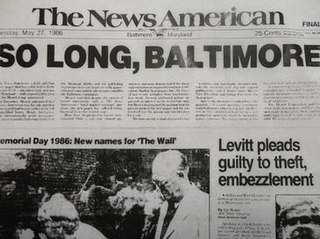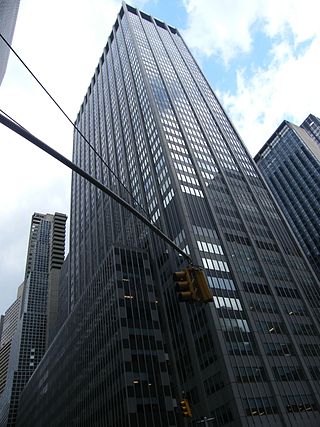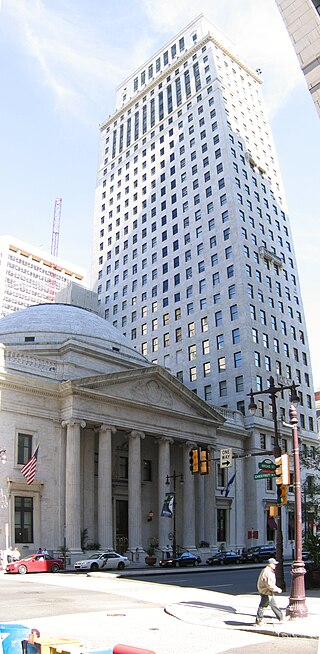
Chase Tower, located in the Chicago Loop area of Chicago, in the U.S. state of Illinois at 10 South Dearborn Street, is a 60-story skyscraper completed in 1969. At 850 feet tall, it is the eleventh-tallest building in Chicago and the tallest building inside the Chicago 'L' Loop elevated tracks, and, as of May 2022, the 66th-tallest in the United States. JPMorgan Chase has its U.S. and Canada commercial and retail banking headquarters here. The building is also the headquarters of Exelon. The building and its plaza occupy the entire block bounded by Clark, Dearborn, Madison, and Monroe streets.

The Baltimore News-American was a broadsheet newspaper published in downtown Baltimore, Maryland until May 27, 1986. It had a continuous lineage of more than 200 years. For much of the mid-20th century, it had the largest circulation in the city.

The Washington Times-Herald (1939–1954) was an American daily newspaper published in Washington, D.C. It was created by Eleanor "Cissy" Patterson of the Medill–McCormick–Patterson family when she bought The Washington Times and The Washington Herald from the syndicate newspaper publisher William Randolph Hearst (1863–1951), and merged them. The result was a "24-hour" newspaper, with 10 editions per day, from morning to evening.

Frank Andrew Munsey was an American newspaper and magazine publisher and author. He was born in Mercer, Maine, but spent most of his life in New York City. The village of Munsey Park, New York is named for him, along with the Munsey Building in downtown Baltimore, Maryland at the southeast corner of North Calvert Street and East Fayette Street.

The Truist Center is a 47-story, 659 feet (201 m) skyscraper in Uptown Charlotte, North Carolina. The city's third tallest building, it is located along North Tryon Street. It was opened on November 14, 2002, and was the city's second tallest building, and was known as the "Hearst Tower" until 2019. The structure is composed of a 32-story tower resting atop a 15-floor podium. During Bank of America's occupancy in the building located on the podium was a three-story trading facility designed by Skidmore, Owings & Merrill and operated by Bank of America. The trading facility included a 6,000-square-foot (560 m2), two-story trading floor. Now the former trading floor is part of Truist's 100,000 square feet (9,300 m2) technology innovation center. The building is currently the headquarters of Truist Financial, which purchased the building in March 2020.

Chevy Chase Bank, F.S.B. was the largest locally based banking company in the Washington Metropolitan Area. It was acquired by Capital One in February 2009, and rebranded as Capital One Bank in September 2010. Despite its name, Chevy Chase Bank was a federally chartered thrift regulated by the Office of Thrift Supervision, rather than a bank.

The Emerson Tower is a 15-story, 88 m (289 ft) clock tower erected in 1907–1911 at 21 South Eutaw Street, at the northeast corner of Eutaw and West Lombard Streets in downtown Baltimore, Maryland. It was the tallest building in the city from 1911 to 1923, until supplanted by the Citizens National Bank building at the southeast corner of Light and Redwood (German) Streets. It was designed by local architect Joseph Evans Sperry (1854-1930) for Isaac Edward Emerson (1859-1931), who invented the Bromo-Seltzer headache remedy.

The New York Evening Mail (1867–1924) was an American daily newspaper published in New York City. For a time the paper was the only evening newspaper to have a franchise in the Associated Press.

Transamerica Tower and originally built as the USF&G Building, serving as headquarters of the United States Fidelity and Guarantee Company, a specialized insurance company founded in Baltimore in 1896, and relocated here from its former complex of three adjoining early 20th Century masonry structures at the southwest corner of South Calvert and Redwood Streets. Later occupied by and known as the Legg-Mason Building, it is a 40-story, 161 m (528 ft) skyscraper completed in 1973 in downtown Baltimore, Maryland at 100 Light Street on the city block bounded by South Charles, East Lombard, Light and East Pratt Streets, facing the former "The Basin" of the Helen Delich Bentley Port of Baltimore on the Northwest Branch of the Patapsco River and the newly iconic Inner Harbor downtown business waterfront redevelopment of the 1970s–1980s. It is the tallest building in Baltimore and in Maryland.

The Bank of America Building, also known as 10 Light Street and formerly as the Baltimore Trust Company Building, is a 34-story, 155.15 m (509.0 ft) skyscraper located at the corner of East Baltimore and Light Streets in downtown Baltimore, Maryland.

1301 Avenue of the Americas is a 609 ft (186m) tall skyscraper in Manhattan, New York City. It is located on the west side of Sixth Avenue between 52nd and 53rd Streets.

The Barnes and Thornburg Building is a high rise in Indianapolis, Indiana originally known as the Merchants National Bank Building. In 1905, the Merchants National Bank and Trust Company engaged the architectural firm of D. H. Burnham & Company of Chicago to design a new bank headquarters on the southeastern corner of the Washington and Meridian streets, the most important intersection in Indianapolis. Initial occupancy of the lower floors took place in 1908, while the upper floors were not completed until 1912.

Baltimore Equitable Insurance also known as the Baltimore Equitable Society, until 2003 was located at the original headquarters of the Eutaw Savings Bank, is a historic bank building located at Baltimore, Maryland, United States. Originally built as the headquarters for the Eutaw Savings Bank, it is a two-story building with brownstone front and brick sides. It was constructed in 1857 in the Italian Renaissance style. The Eutaw Savings Bank moved across the street in 1887 to what is now the Baltimore Grand and the building was acquired by the Baltimore Equitable Society in 1889. Founded in 1794, the Baltimore Equitable Society is one of the oldest corporations in the city and the third-oldest fire insurance company in the United States.

The Ritz-Carlton Philadelphia is a luxury hotel and residential complex that is located in Center City, Philadelphia, Pennsylvania, United States. It comprises three adjoining buildings: the Girard Trust Bank, at the northwest corner of South Broad & Chestnut Streets, the Girard Trust Building, at the southwest corner of South Broad Street & South Penn Square, and The Residences at the Ritz Carlton, at 1414 South Penn Square.

15 Broad Street is a residential condominium and former office building in the Financial District of Manhattan, New York City, on the eastern side of Broad Street between Wall Street and Exchange Place. It has entrances at 51 Exchange Place and 35 Wall Street.
Vlastimil Koubek was a Czech American architect who designed more than 100 buildings, most of them in the Washington, D.C., metropolitan area. When he died, he had designed buildings worth more than $2 billion. Most of his work is Modernist in style, although he developed a few structures in other vernaculars. He created the site plan for the redevelopment of Rosslyn, Virginia, and his Ames Center anchored the area's economic recovery. He also designed the World Building in Silver Spring, Maryland, which sparked redevelopment of that town's downtown and the L'Enfant Plaza Hotel in Washington, D.C., amongst many other buildings. In 1985, Washingtonian magazine considered him to be one of 20 people "who in the past 20 years had the greatest impact on the way we live and who forever altered the look of Washington." In 1988, The Washington Post newspaper said his Willard Hotel renovation was one of 28 projects in the area which made a signal contribution to the "feel" and look of Washington, D.C.

Charles Henry Grasty was a well-known American newspaper operator who at one time controlled The News an afternoon paper begun in 1871 and later The Sun of Baltimore, a morning major daily newspaper, co-founded 1837 by Arunah Shepherdson Abell, William Moseley Swain and recently joined by Grasty with a companion afternoon edition entitled The Evening Sun in 1910. Grasty was named among the great American newspaper publishers and owners, such as James Gordon Bennett, Benjamin Day, Joseph Pulitzer and William Randolph Hearst. Grasty owned the Evening News, which had been founded in the early 1870s and utilized the new illustrative technology of using woodcuts illustrations plates to show pictures spread across its pages before the advent of reprinting photographs directly on newspaper pages. During Grasty's tenure The News built its elaborate tall headquarters and printing plant with a corner clock tower on the southwest corner of East Baltimore and South Streets directly across the street from The Sun's older architectural landmark "Sun Iron Building" of 1851, on the southwest corner, constructed of newly popular cast iron architecture style and supposedly fireproof and an early version of a tall commercial office building that gained increasing popularity in American big cities known as the skyscraper. Grasty ran The News for a number of years greatly increasing its circulation and cultural and civic impact on the city as its leading afternoon paper and later sold it prior to briefly acquiring the Minnesota Dispatch and the St. Paul Pioneer Press in the Upper Midwest in separate transactions then later divesting these newspapers to return again to Maryland to seek ownership of The Sun with a syndicate of wealthy backers. Grasty was also one of the developers of the new northern suburban Roland Park community in the early 1890s by the Roland Park Company development firm, said to be an early innovation in community planning, including planned shopping centers and other aspects of the community prior to being offered for sale and development.

















